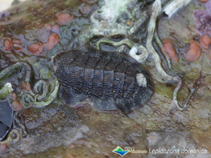Lepidozona coreanica (Reeve, 1847)
Korean chitonWarning: DOMDocument::load(): SSL operation failed with code 1. OpenSSL Error messages: error:140770FC:SSL routines:SSL23_GET_SERVER_HELLO:unknown protocol in C:\Apache24\htdocs\includes\SpeciesSummary.lib.php on line 1236
Warning: DOMDocument::load(): Failed to enable crypto in C:\Apache24\htdocs\includes\SpeciesSummary.lib.php on line 1236
Warning: DOMDocument::load(https://sealifebase.nrm.se/webservice/AquaMaps/getAMap.php?genus=Lepidozona&species=coreanica): failed to open stream: operation failed in C:\Apache24\htdocs\includes\SpeciesSummary.lib.php on line 1236
Warning: DOMDocument::load(): I/O warning : failed to load external entity "https://sealifebase.nrm.se/webservice/AquaMaps/getAMap.php?genus=Lepidozona&species=coreanica" in C:\Apache24\htdocs\includes\SpeciesSummary.lib.php on line 1236
Classification / Names Common names | Synonyms | CoL | ITIS | WoRMS
| Chitonida | Ischnochitonidae
Environment: milieu / climate zone / depth range / distribution range Écologie
. Subtropical
Distribution Pays | Zones FAO | Écosystèmes | Occurrences | Introductions
Northwest Pacific: Japan, China, Taiwan, Hong Kong, and Korea.
Length at first maturity / Taille / Poids / Âge
Maturity: Lm ? range ? - ? cm Max length : 3.8 cm TL mâle / non sexé; (Ref. 283)
Description synthétique Morphologie
Body oval to elongate; oval in shape; moderately elevated. Valves yellowish brown or greenish in color blotched with dark brown or dark green. Lateral areas distinctly raised and sculptured with low radial ribs, some bifurcating towards the outer margin. Each rib ornamented with medium to large, roundish pustules. Central areas with fine, longitudinally, granosely ridged with twenty to twenty-five ridges per side. Girdle with alternating bands of light yellowish and dark greenish brown color; covered with rather large, slightly bent scales.
Found from intertidal to 10 m (Refs. 289, 75835). Motile burrower. Feeds using its radula (Ref. 125928).
Life cycle and mating behavior Maturité | Reproduction | Frai | Œufs | Fécondité | Larves
Members of the class Polyplacophora are mostly gonochoric. Life cycle: Eggs hatch into lecitotrophic planktonic trocophore larvae (no veliger stage) which later metamorphose and settle on the bottom as young adults.
Référence principale
Références | Coordinateur | Collaborateurs
Burghardt, G. and L. Burghardt. 2006. (Ref. 283)
Statut dans la liste rouge de l'IUCN (Ref. 130435)
statut CITES (Ref. 108899)
Not Evaluated
CMS (Ref. 116361)
Not Evaluated
Menace pour l'homme
Harmless
Utilisations par l'homme
| FishSource |
Outils
Plus d'informations
Pays
Zones FAO
Écosystèmes
Occurrences
Introductions
Stocks
Écologie
Régime alimentaire
Éléments du régime alimentaire
Zones FAO
Écosystèmes
Occurrences
Introductions
Stocks
Écologie
Régime alimentaire
Éléments du régime alimentaire
Sources Internet
BHL | BOLD Systems | CISTI | DiscoverLife | FAO(Publication : search) | Fishipedia | GenBank (genome, nucleotide) | GloBI | Gomexsi | Google Books | Google Scholar | Google | PubMed | Arbre de Vie | Wikipedia (Go, chercher) | Zoological Record
Estimates based on models
Preferred temperature
(Ref. 115969): 14.9 - 23, mean 20 (based on 152 cells).
Catégorie de prix
(Ref. 80766):
Unknown.



